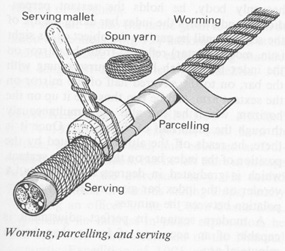I made this polissoir to be about 2" in diameter. The materials used were 2 broomcorn hand brooms and some waxed whipping twine. You can use many different natural fibers for the tool. The original (Roubo) was made with common rush and the ones sourced by Don Williams are made with broomcorn.
Tools needed:
2-3 hose clamps
adjustable jaw pliers
large durable needle (I used a size 22)
dykes, dikes, side cutting pliers (whichever name you call them)
small clamp
solid knife
Acquire your natural bristle material and twine. One broom was from the orange store, the other from the blue store, and the twine was from a marine/boating/sailing store.
image1.jpg
Take apart the broom by pulling off the nailed on end cap. This will give you easy access to the wire binding. Cut the wire binding under the cap or pull it off of the nail it is wrapped around. There is an outer layer and an inner folded layer that is bound by the wire.
image2.jpg
Separate the loose bristles from the bound and fold the bound bristles down. Cut the bristles that were folded down, leaving the inner most bristles in place. To the left is what is left after removing all bristles used. The right side shows the material from the two hand brooms. I surrounded the longer fibers with the shorted fibers in a mostly even layer. The inner fibers are the thicker, solid core fibers. The outer fibers do have a hollow core and are a little more soft.
image3.jpg
Bind the bundle with the hose clamps. I bound the far end of the bundle to keep things under control and the near end with two tightly closed hose clamps. The winding will start between these two tightly bound hose clamps. The hose clamps should be closed to the same diameter and be very tight. The area between should also be flat and not humped, I learned this the hard way.
image4.jpg
Thread the needle and push it through the flat area between the hose clamps. It helps to use the pliers to push the needle through and pull it out of the far side. Try to keep the entry and exit close to the hose clamp. This will make the wrapping smoother by not having to go over a layer of twine.
image1 (2).jpg
Move over about 1/4", or so, and push the threaded needle back trough the bundle. This will create a lock stitch for the twine to be wrapped. I then pushed the needle back into the bundle all of the way up to the eye. Pull the twine tight and trim the tail just shorter than the thickness of the bundle and pull through. This will terminate the end of the twine inside of the bundle.
image2 (2).jpg
Pull out several feet of twine and secure the spool end to a fixed object. I wrapped the twine over itself and around my pop up vise bench dog. This will lock the twine in place for you to pull against it.
image3 (2).jpg
Pull the bundle taunt and begin to slowly wrap the twine. Start next to the outer most hose clamp and pull the twine to where it is under flexed tension. When wrapping, keep the twine tight against itself but to where it falls on the correct side of the previous wrap. This will help in keeping each layer of the wrap tightly together and no gaps between.
image5 (1).jpg




 Reply With Quote
Reply With Quote





